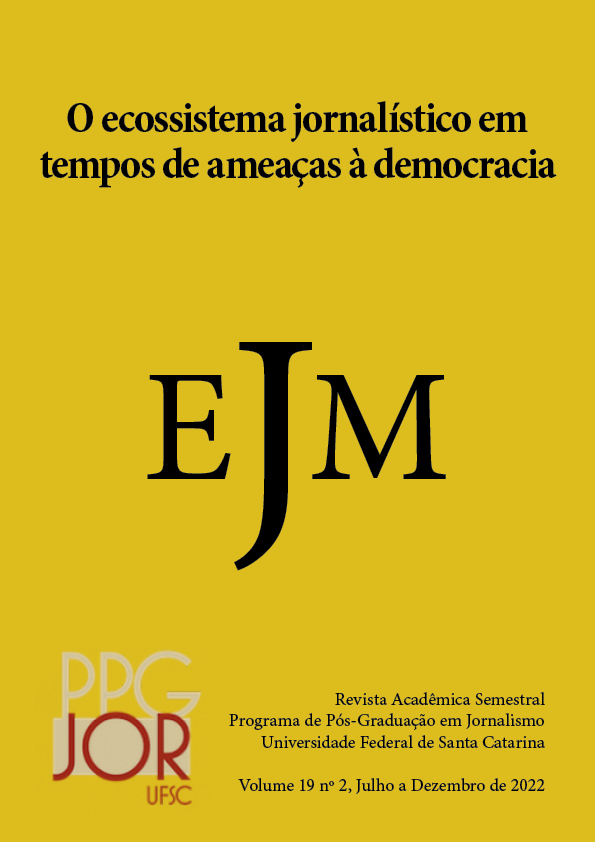Journalists, harassment and violence in the digital and physical environments: the Brazilian landscape
DOI:
https://doi.org/10.5007/1984-6924.2022.83476Keywords:
Journalism, Public Sphere, ViolenceAbstract
Harassment and violence against journalism and journalists have been a constant feature of Brazilian society. The evolution of these processes and the transformation of social actors takes on significant dimensions with digitalization and with political-electoral and pandemic crisis events. We aim to present an exploratory-analytical look at how violence against Brazilian journalists has been occurring between 2020 and 2021, the central moment of such occurrences. The conceptual construct starts from the approaches to journalistic practice in the digitalized public sphere based on Burgress & Hurcombe (2019), and from aspects focused on the sociological approaches to violence based on Busquets (2019) and Galtung (1969, 1990). Exploratory, quantitative and qualitative research results from a triangulation process constituted by the theoretical-conceptual construct; for data produced by legitimate sources: FENAJ, ABRAJI, Reporters Without Borders; and a survey of records on violence against journalists via Google Alerts.
References
ABRAJI. (2021). Projeto CTRL-X. Disponível em <https://www.ctrlx.org.br/#/infografico>. Acesso em 9 jul 2021.
ANDERSON, Chris. A cauda longa. São Paulo: Editoral Actual, 2017.
BLOTTA, Vitor. Brasil: a mordida do ouroboro. Infoamérica: Iberoamerican Communication Review, 9-21, 2016.
BRAGA, M. J. Violência contra jornalistas e Liberdade de imprensa no Brasil. FENAJ – Federação Nacional dos Jornalistas.
Brasília: Ed. FENAJ, 2021. Disponível em <https://bit.ly/32r4Mxl >. Acesso em 7 mai 2021.
BURGESS, J. & Hurcombe, E. Digital Journalism as Symptom, Response, and Agent of Change in the Platformed Media Environment. Digital Journalism, 7:3, 359-367, DOI: 10.1080/21670811.2018.1556313, 2019.
CANO BUSQUETS, M. Violencia contra los periodistas: Configuración del fenomeno, metodologias y mecanismos de intervención de organizaciones interna- cionales de defensa de la libertad de expresión. Bogotá: Editorial Pontificia Uni- versidad Javeriana, 2019.
CAMPOS MELO, Patricia. A máquina do ódio: notas de uma repórter sobre fake news e violência digital. São Paulo: Companha das Letras, 2020.
CARNEIRO, E. Resumo do Cenário digital 2020. ComScore. Disponível em <https://bit.ly/2RMcWhE >. Acesso em 2 jul 2021.
ComScore. Últimos Rankings. 2021 Disponível em <https://www.comscore.com/por/Insights/Rankings-do-Mercado>. Acesso em 2 jul 2021.
FENAJ. Violência contra jornalistas e Liberdade de imprensa no Brasil. FENAJ – Federação Nacional dos Jornalistas. Brasília: Ed. FEANAJ, 2020. Disponível em <https://tinyurl.com/yeqfsnfj>, Acesso em em 2 jul 2021.
GALTUNG, Johan. Violence, Peace, and Peace Research. Journal of Peace Research, Vol. 6, No. 3 , pp. 167-191, 1969.
GALTUNG, Johan. Cultural Violence. Journal of Peace Research, Vol. 27, No. 3 (Aug., 1990), pp. 291-305, 1990.
GILLESPIE, Tarleton. The relevance of algorithms. Media Technologies: Essays on Communication, Materiality, and Society. Cambridge: MIT Press, 2014.
GOMES, Wilson. & Maia, Rousiley. Comunicação e democracia. Problemas & Perspectivas. Editora Paulus: São Paulo, 2008.
JORGE, Fernando. Cale a boca, jornalista!: O ódio e a fúria dos mandões contra a imprensa brasileira. São Paulo: Novo século, 2020. [Kindle iOS version].
KALIL, I. & Santini, R. M. Coronavírus, Pandemia, Infodemia e Política. Relatório de pesquisa. Divulgado em 01 de abril de 2020. 21p. São Paulo / Rio de Janeiro: FESPSP / UFRJ, 2020.
KOIRALA, S. Female Journalists Experience of Online Harassment: A Case Study From Nepal. Media and Communication, Volume 8, Issue 1, pp. 47-56. DOI: 10.17645, 2020.
LELO, T. V.. A naturalização do assédio moral no jornalismo digital. Revista Media & Jornalismo, 207-221. DOI: https://doi.org/10.14195/2183-5462_38_10, 2021.
MESQUITA, Lucia. & de Lima Santo, M. Approaches of resistance and resilience for investigative journalism in Latin America. 6th International Conference on the Safety of Journalists – Risks, Resistance, Resilience, 2020. OsloMet, Noruega. Apresentação online.
NEWMAN, N., FLETCHER, R., SCHULZ, A., ANDI, S., NIELSEN, R. K. Digital News Report 2020. Londres: Reuters Institute for Study of Journalism, 2020. Disponível em <https://bit.ly/3n1LE27>. Acesso em 6. Jun 2021.
PARISER, E. The Filter Bubble. New York: The Penguin Press, 2011.
PASQUALE, Frank. The automated Public Sphere. The Social Science Research Network Electronic Paper Collection, 2021. Disponível em <http://ssrn.com/abstract=3067552>. Acesso em 22 Abr 2021.
RIOS, A; BRONOSKY, M. E. Violências contra jornalistas, ameaça à sociedade. Mosaico, v.11, n. 17, 2019. DOI: https://doi.org/10.12660/rm.v11n17.2019.81064. Disponível em: http://bibliotecadigital.fgv.br/ojs/index.php/ mosaico/article/ view/81064. Acesso em: 22 abr. 2021.
RSF - REPÓRTERES SEM FRONTEIRAS. Ranking Mundial da Liberdade de Imprensa 2021: vacina contra a desinformação, o jornalismo segue cerceado em mais de 130 países. Disponível em: https://rsf.org/pt. Acesso em: 30 abr. 2021.
SAKAMOTO, L. Entrevista concedida a Daniela Ramos e Elizabeth Saad. São Paulo, 2019.
SEABRA, C. Jornalismo, democracia e afetos: ódio, medo e ressentimento no pri- meiro ano do governo Bolsonaro. Rev. ComPolis, Rio de Janeiro, v. 1, n. 1, p. 84- 112, fev./mai. 2020.
SOUZA, J; AVELINO, R; SILVEIRA, S. A. (org.). A sociedade de controle: mani- pulação e modulação nas redes digitais. São Paulo: Hedra, 2018.
WIEVIORKA, M. O novo paradigma da violência. Tempo Social, São Paulo, v. 9, n. 1, p. 5-41, mai. 1997. DOI: 10.1590/ts.v9i1.86437. Disponível em: https://www. revistas. usp.br/ ts/article/view/86437. Acesso em: 9 jul. 2022.
Downloads
Published
Issue
Section
License
Ao encaminhar textos à revista Estudos em Jornalismo e Mídia, o autor estará cedendo integralmente seus direitos patrimoniais da obra à publicação, permanecendo detentor de seus direitos morais (autoria e identificação na obra), conforme estabelece a legislação específica. O trabalho publicado é considerado colaboração e, portanto, o autor não receberá qualquer remuneração para tal, bem como nada lhe será cobrado em troca para a publicação. As ideias e opiniões expressas no artigo são de exclusiva responsabilidade do autor, não refletindo, necessariamente, as opiniões da revista. Citações e transcrições são permitidas mediante menção às fontes. A revista Estudos em Jornalismo e Mídia está sob a Licença Creative Commons



